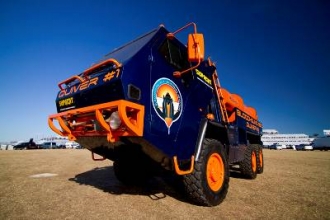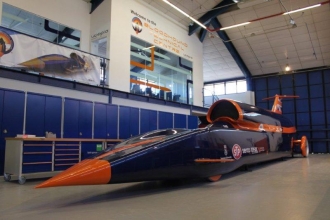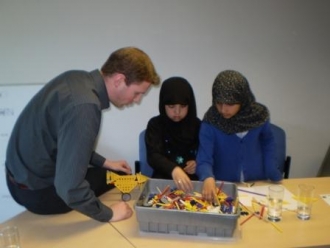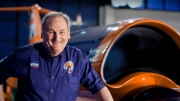Thank God August is behind us! For us August is a dead month – key contacts are on holiday and we lose half the team for their breaks. That’s uncharitable, but the reality is that everyone needs the break –it's getting very tough now as the project advances into the build and delivery phase.
So let's look forward now to roll–out in December 2011. We have to achieve the following – make at least £3.2m, complete the build of the car, rewrite plans for and update the education programme and develop the media machine to include our new web site and video productions. Amongst that lot, we also attend around 100 shows and exhibitions. There’s also the no small objective of the desert preparation at Hakskeen Pan which Northern Cape Government start this month – the idea being to allow the desert a year in which to heal from the surgery of removing the stones and the 1.6km road and causeway.
But as any Director knows, expanding the company by 300% at any time is just not easy. Firstly there is the massive increase in working capital required to meet the gaps between sponsor money inflow and payment of bills and team, then there is the need for more people as almost all the team have been working flat out even to get to this stage – and we have to go much further. Then there is the need to relook at the company structure – can it support what we are trying to do and can it accommodate growth and change? And then there is the team – are we now asking people to take on workload beyond their capability? How do we do all this without a serious increase in the team numbers – which would make the project slow and uncontrollable?
 All this means that there are suddenly huge new opportunities for sponsors. Will they rise to the challenge? How will they respond to the opportunities? A great example is our good friends at Supacat who supported us with Supacat vehicles for ThrustSSC and are generously providing the 2 high speed Supacat HMT 600 6x6support vehicles for Bloodhound SSC – known as Quiver #1 and Quiver #2. These brilliant vehicles carry the spare rockets, dilution water and supplies for the car, are an essential part of the record attempt turnaround – you may have seen Quiver #1 at Farnborough. Suddenly Chief Executive Nick Jones finds Supacat and Bloodhound splashed all over The Sun – not page three, but the centrefold on September 9th and read by over 3 million people! A few days earlier Autocar gives the project four pages and ace road tester Steve Cropley urges the readers to get behind Bloodhound and get their names on the tailfin. This results in a huge daily financial surge on fin sales – which is much needed as August and December are the dreaded dead months.
All this means that there are suddenly huge new opportunities for sponsors. Will they rise to the challenge? How will they respond to the opportunities? A great example is our good friends at Supacat who supported us with Supacat vehicles for ThrustSSC and are generously providing the 2 high speed Supacat HMT 600 6x6support vehicles for Bloodhound SSC – known as Quiver #1 and Quiver #2. These brilliant vehicles carry the spare rockets, dilution water and supplies for the car, are an essential part of the record attempt turnaround – you may have seen Quiver #1 at Farnborough. Suddenly Chief Executive Nick Jones finds Supacat and Bloodhound splashed all over The Sun – not page three, but the centrefold on September 9th and read by over 3 million people! A few days earlier Autocar gives the project four pages and ace road tester Steve Cropley urges the readers to get behind Bloodhound and get their names on the tailfin. This results in a huge daily financial surge on fin sales – which is much needed as August and December are the dreaded dead months.
The fin sales are turning out to be a great success – the system is electronic , the purchasers get their names on the fin and a very smart personalised certificate. It also make a great gift because it appears to the lucky recipient to be a rare expensive and unusual present. Buy now for Christmas!!
Of course the money is tough. The average cost per month goes from £110,000 to £225,000 and the whole sponsorship programme depends on what we call the stepping stone programme. The idea is that each new sponsorship represents a stepping stone as we work our way through the build or to continue the analogy, across the fast flowing river. The problem doesn’t lie with the stepping stone you are just about to commit the project to, but it's the steeping stones two or three paces ahead – will they be in place by the time you need them? Will they be safe enough deals to commit the project to? Do we have enough effort or time available to find alternatives if the next stones appear to be shakey?
It would of course be very comfortable to have the money for the build lying in the bank earning interest and ready to spend when we need it. Bloodhound and the Thrust projects have never worked like that. Because we are an unusual project, the value isn’t appreciated until it completes and so the only option is to make the money shortly before we spend it. It's called Just In Time finance. It's far far worse than a hand to mouth existence – it's hand to stomach!
However as we advance, with each step forward the risk reduces and this opens up new funding opportunities. Also the amount of ad space on the car reduces and that generates a sense of urgency –as they say, the train is pulling out of the station. The opportunities are diminishing – pretty soon the train will be over the points and out of sight.
 At one of our recent Strategy Meetings, someone raised the question about Plan B – an alternative plan if the existing plan doesn’t work. We quickly realised that a slower build plan just isn’t practical – the sponsors expect and link their plans with the programme we promise and if we go slower to stretch the money, the build costs will rise as the project extends far into the future – each time the costs rise the project will take even longer: we wouldn’t be able to deliver on the sponsors publicity requirements and that means loss of faith in the project and only leads one way - to no more sponsors. So there is only one way forward and that is to move quickly keep the costs down and go for it!
At one of our recent Strategy Meetings, someone raised the question about Plan B – an alternative plan if the existing plan doesn’t work. We quickly realised that a slower build plan just isn’t practical – the sponsors expect and link their plans with the programme we promise and if we go slower to stretch the money, the build costs will rise as the project extends far into the future – each time the costs rise the project will take even longer: we wouldn’t be able to deliver on the sponsors publicity requirements and that means loss of faith in the project and only leads one way - to no more sponsors. So there is only one way forward and that is to move quickly keep the costs down and go for it!
This delivery objective means a huge change in culture. In the past we were glad when team members diverted from their jobs to come up with bright ideas and concepts – the whole team was innovating and the way forward was very far from obvious. Now everyone has to focus hard on their immediate objectives and make sure they deliver ahead of plan. Any deviation is likely to be a waste of precious resource. Key to all this is the Critical Path planning. The critical path represents the project key working activity which by itself defines the whole project timing. So if for example James Painter is on the critical path this week and something goes wrong and his one week schedule takes two weeks instead of one, it has just cost the company £56,250 because we have to add another week to the entire production schedule. Of course the converse is true and James being James is much more likely to complete the job in 2.5 days – in which case he has just saved us £28,125. The trick for everyone is to know where the Critical Path lies and who is the lucky person operating on it that week. Alongside that is the requirement on everyone for iron-hard self discipline and a clear understanding that we all have to beat the plan.
Bloodhound is at serious risk as we work our way through the build – but once we have that car completed we have a huge global promotional asset and the project risk should come down. In fact in Britain we tend to be a nation of pessimists, and the perceived risk actually goes up because everyone is then asking the question – OK we have the car now, will it work? That’s not a problem at our end because after three years work we KNOW it will work fine.
The education team has now achieved the total of 3,829 UK schools colleges and Universities with a further 400 studying Bloodhound overseas. This means that there are over 1.5m UK school kids studying Bloodhound. It's a huge achievement. But now we have to change to start producing more curriculum relevant programmes for the UK schools and also producing e-learning programmes for the web so that web followers can be brought up to speed on the Bloodhound technology and thus be in a position to fully understand the data that comes from Bloodhound's 450 data channels when the car starts to run in 2012. For the higher education there is the need to collect and tag all the design data and provide explanations and commentary and all this with near zero impact on the design team. It's September today and we have only 16 months – and all that has to be added to Nick Chapman’s new website which is near completion as I write.
 Another factor we have looked at is the support for the schools. We have 8 key team members on education and the project is building fast. We might soon find ourselves at this rate with 7,000 UK schools. How on earth do we support that lot? The answer lies with the Bloodhound Ambassador team under Jonathan Ellis. All of our Ambassadors have qualified under the UKs ambassador scheme and we feel that we have to do a lot better for our ambassadors who have helped enormously at shows and exhibitions (we do 100 events a year). And we had better do it quickly! The requirement is to run all the Ambassadors through a two day course to get them up to speed on Bloodhound and to give them the skills and confidence to go into schools and present Bloodhound. And we need to link them with their local schools and communicate with them frequently. How many ambassadors do we think we need? 400 at least – apply immediately, more information here!!
Another factor we have looked at is the support for the schools. We have 8 key team members on education and the project is building fast. We might soon find ourselves at this rate with 7,000 UK schools. How on earth do we support that lot? The answer lies with the Bloodhound Ambassador team under Jonathan Ellis. All of our Ambassadors have qualified under the UKs ambassador scheme and we feel that we have to do a lot better for our ambassadors who have helped enormously at shows and exhibitions (we do 100 events a year). And we had better do it quickly! The requirement is to run all the Ambassadors through a two day course to get them up to speed on Bloodhound and to give them the skills and confidence to go into schools and present Bloodhound. And we need to link them with their local schools and communicate with them frequently. How many ambassadors do we think we need? 400 at least – apply immediately, more information here!!
Schools Minister Michael Gove wrote a key column in the Sunday Times on August 15th. It seems that there is an international education comparison organisation known as PISA which ranks countries according to education standards. According to Gove and PISA, the UK has fallen drastically in the rankings over the last ten years – from 4th to 14th in Science , from 7th to 17th in literacy and from 8th to 24th for the all essential maths. So it would seem that while the UK kids have been collecting A Stars and awards for perfection in huge numbers, the whole UK education machinery has been sliding steadily downhill. Want a good education – try Finland or South Korea!
One of the key concerns of all this is the perils of self delusion. As a project, we are innovating with this education at a considerable rate and putting in a huge effort. Is it appreciated? Is it worthwhile? Have we got this right? Well the YouTube figures are pretty interesting – it looks like 1.6 million Bloodhound viewings so far – and that's before we have the car! By comparison ThrustSSC has done 13 million YouTube viewings – so there is a huge potential ahead of us. The web stats are beginning to define the profile –Bloodhound is now being followed in 203 countries while still retaining the early predominance of the UK and the USA. It's also possible to trace the growth of the virals with very considerable interest in the latest Intel viral in the Pacific Rim countries.
As all this comes together, you can't help but ask the question 'Are there other countries which need to develop their STEM skills quickly, perhaps moving away from an old oil based economy to a high technology industrial alternative and could they benefit from Bloodhound education experience?' Perhaps there are. Perhaps we could all work together and share the opportunities!
 Just for a very short time at the end of August we were able to bring the beautiful show car to the Bloodhound Technical Centre in Bristol and position it in the workshop exactly where the real car will be in 16 months time. I didn’t manage to get to Bristol until we held the three open days for the Gold 1K members at the end of August – the show car looked a million dollars and it was very noticeable that no one could take their eyes off it or even stand with their backs to it.
Just for a very short time at the end of August we were able to bring the beautiful show car to the Bloodhound Technical Centre in Bristol and position it in the workshop exactly where the real car will be in 16 months time. I didn’t manage to get to Bristol until we held the three open days for the Gold 1K members at the end of August – the show car looked a million dollars and it was very noticeable that no one could take their eyes off it or even stand with their backs to it.
Here in the Back Office we drive up funding, the pressure is extreme – the funding targets have to be met each month and we are dealing with large corporations who don’t move at our pace. Even worse the senior executives we are negotiating with are themselves working at a stressful pitch and sometimes it takes months to get a simple contract signed off. The deals going through this September have taken nearly two years to accomplish. The critical need is to get the meetings nailed as quick and as early as we can and that leads to more stress as all the necessary pre-meeting research has to be completed in time. Bringing meetings forward hopefully brings the cheques in earlier. It also has a bad effect on the personal scheduling because there is no way we can enjoy the comfort of linking multiple meetings with time and geography – we just have to drive further and already my car is coming up to 100,000 Bloodhound miles in three years!
I was doing a check for our accounts on the sales of merchandise and donations from the public this year – so far totalling £163,000 in 8 months –or £20,000 a month – nearly 10% of our monthly build cash burn. This is incredibly healthy, generous and very valuable.
In parallel of course we have to manage the funds, run the accounts and get the accounts checked every three months by the accountants. Almost all the funds go into the engineers and the build - so the rest of the organisation has to operate from their homes and a garages!
At the Financial sponsors meeting this week, one of the sponsors made the point ‘This is the largest science based education project we have ever seen!'
Now here is another interesting point – there only are four large ad spaces on Bloodhound – for four large sponsors. It gives us a strong negotiation position. Also we only have six of the Stripe Sponsor positions left. In the meantime the SME sponsorships for the small companies are beginning to move –we need to sell two of these each month. The SME sponsors get a small ad on the car, buy the right to call themselves Bloodhound SME sponsors and use the logo – and it only costs £10,000/annum and more details are here.
So here we go, deep into the tough fight to get the Bloodhound SSC built. A huge amount has already been achieved and Conor has 220 companies supplying components now worth £5m. Are we going to be able to handle this whole programme smoothly with the finances coming in comfortably ahead of the build costs – or is it going to be a ThrustSSC type fight for survival every week for 16 months?
We might just be lucky – this is innovation - nobody knows and only time will tell!
But one thing we all know is that we have a totally brilliant and thorough design and a truly great team – but it's a rocky road and we all have a very long way to go.
Richard N. September 2010.


